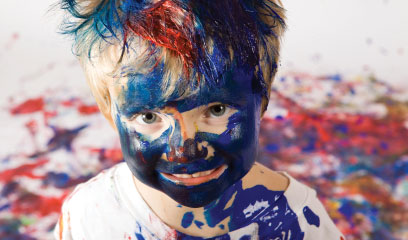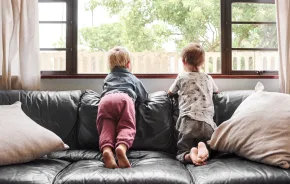 Paint splattered walls, clay in the carpet -- the price you may pay for your mini-Monet! But once you get past the mess, experts say, you're giving your toddler a priceless gift when you encourage him or her to explore art at home. Here are some tips for taming the mess while coaxing out your child's inner artist.
Paint splattered walls, clay in the carpet -- the price you may pay for your mini-Monet! But once you get past the mess, experts say, you're giving your toddler a priceless gift when you encourage him or her to explore art at home. Here are some tips for taming the mess while coaxing out your child's inner artist.
Two-year-old Ginger keeps all of her artistic works-in-progress, her special crayons, stickers and scissors in her own personal box. "This cuts down on the mess a bit and gives her the freedom to return to her project whenever she wants," says her mom, Tera Schreiber of Seattle. Both of Schreiber's daughters (Daisy is four) ask her if they can do an art craft project almost every day. "They love art!" Schreiber says. To encourage their creativity, she keeps a table and chairs set up in the living room, with the art supplies they use most nearby at kid level.
That easy access to art is key to free expression, says Kimberly McKenney, content manager at the Children's Museum of Tacoma. "Parents can create an environment that nurtures their child's creativity by providing a special time and place for art making," McKenney says. Having an art easel set up all the time, or a wall covered with chalkboard paint, allows free access to art making. Keep child-safe art supplies close at hand. Beyond that, covering the kitchen floor with a vinyl tablecloth, getting out a variety of art supplies and sitting on the floor with your toddler sends him the message that art is something fun and special to do together.
"Creating art is a skill that takes exposure and practice in order to build a knowledge base, much like sports, reading or math," says McKenney. "The more children experiment with artistic media and techniques, the more comfortable and confident they become in their ability to create and express themselves."
The benefits of early art
Little artists, even those younger than two, develop problem-solving skills and open up avenues for self-expression as they experiment. Art also builds hand-eye coordination and helps them gain fine-muscle control that will help them later with handwriting.
"At this age, children are primarily focused on the process of art, exploring the characteristics of different materials and discovering what their bodies can do with the materials," says McKenney. This means you'll probably have to remind them to keep paint out of their mouths more than once, so make sure it's non-toxic.
"In a simple way, art is exploring their world," says Una McAlinden, executive director of ArtsEd Washington, a Seattle nonprofit. "Have them feel different textures like a brick wall or velvet fabric or collect some leaves to put on construction paper, but keep the art activity simple." She recommends toddlers use just one color when they finger paint. "Don't offer him a dozen colors," says McAlinden. "He will just be overwhelmed and frustrated."
McKenney says parents should be prepared to go through a lot of art materials. "The hallmark of toddler art is the use of lots of supplies," she says. But the type of materials you offer ultimately depends on your willingness to monitor the mess and keep your little artist safe. If the art supply your child is working with can pass freely through a toilet paper tube, it is a choking hazard, and the toddler needs to be supervised when using it.
A well-stocked "art studio"
Having a variety of interesting art supplies on hand will spark your child's interest in art. Non-toxic crayons, markers, lots of paper, glue, stickers, paints, toilet paper tubes, felt, egg cartons and many recyclables can be used for an assortment of art projects. You can even let your toddler finger paint in the bathtub using chocolate pudding on those days when you want to keep clean-up to a minimum. Marci Knutsen, owner of Museo Art and Design in Issaquah, recommends clay for little ones, because it's fun and easy to use and encourages fine-motor development.
Schreiber keeps messy art materials like glitter, washable ink pads, foam, cotton balls, dried beans and paints in a limited-access area, out of reach. She suggests parents try to relax about the mess, but be sure to supervise so your little artists stay safe and you stay sane.
Words of encouragement
Some children will experiment more than others with art, McAlinden says, but parents should think twice before stepping in. "Only make suggestions on what to do if the toddler is hesitant," she says. "If he doesn't appear to know what to do with clay or Play-Doh, you might ask him, 'What do you think will happen if we squeeze this?' Then you can both try squeezing the material."
When your toddler declares his art creation is finished, the last thing you should say is, "What is it?" says McAlinden. "He knows what it is and he thinks it's obvious," she says. She suggests parents instead say, "Tell me about your picture;" ask about what's happening in the picture and why it is happening. Use this opportunity to have a two-way dialogue, McAlinden suggests.
"Encourage and value art exploration for the sake of the experience," says McKenney. "Remember, it's the process, not the product that's most important."
Heather Larson is a freelance writer based in Tacoma who frequently writes about pregnancy and parenting.
How to make scented play dough
Courtesy of Children's Museum of Tacoma
Materials:
3 1/2 cups of flour
3 packets unsweetened powdered drink mix
3 tablespoons vegetable oil
1/2 cup salt
2 cups very hot water
Food coloring Instructions:
1. Mix dry ingredients together; add water and oil. Mixture will be sticky.
2. If more color is desired, add the same hue of food coloring.
3. Turn out onto a smooth surface sprinkled with flour. Knead and add more flour slowly until the right consistency has been reached.
4. Sculpt and create with fragrant dough. Keep the dough in an airtight container.
28 suggested art supplies for toddlers
Here are some basic materials our sources suggest you on hand for your toddler's art explorations. Remember to make sure all materials are non-toxic and washable.
- Clay
- Play-Doh
- Finger paints
- Crayons
- Watercolor markers
- Non-toxic and washable paints
- Stickers
- Stamps and ink pads
- Glue sticks
- Glitter
- Foam
- Yarn
- Dried beans
- Cotton balls
- Fabric scraps
- Old magazines
- Toy bricks and blocks for sculpture
- Felt strips on a felt board
- Egg cartons
- Toilet paper tubes
- Construction paper
- White glue
- Pencils
- Clear contact paper
- White paper
- Pre-cut foam and paper shapes
- Pom-poms
- Cotton balls











